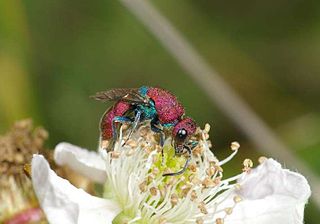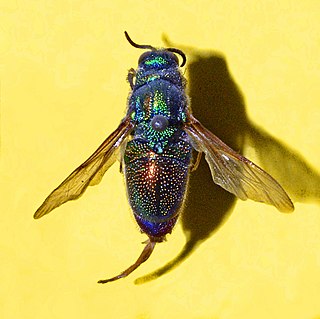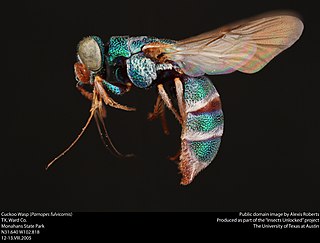
Commonly known as cuckoo wasps or emerald wasps, the hymenopteran family Chrysididae is a very large cosmopolitan group of parasitoid or kleptoparasitic wasps, often highly sculptured, with brilliant metallic colors created by structural coloration. They are most diverse in desert regions of the world, as they are typically associated with solitary bee and wasp species, which are also most diverse in such areas. Their brood parasitic lifestyle has led to the evolution of fascinating adaptations, including chemical mimicry of host odors by some species.

The subfamily Chrysidinae contains those species that are most commonly recognized as cuckoo wasps, being by far the largest and most familiar subfamily. The group contains 3000 species with 48 genera worldwide. They are highly sculptured, with brilliantly metallic-colored bodies, covering the entire spectrum, but primarily blues and greens.

Chrysis inaequalis is a species of cuckoo wasps. The species occurs in Central and Southern Europe and in the Near East. The head and the thorax are shiny metallic blue-green, while the abdomen is red. Adults grow up to 5–10 millimetres (0.20–0.39 in) long and can be encountered from late June to mid September, especially flying on sun-exposed walls, on rocks and on dead wood.

Hedychrum rutilans is a species of cuckoo wasps. The species occurs primarily in Austria, Italy, Bulgaria, Greece, France, Poland, Portugal, Spain, Switzerland and in North Africa. The head and thorax are metallic green with red spots, while the abdomen is red. The color is more green and partially golden in the male and more extensively golden-red in the female. The body is somewhat hairy.

Chrysis ignita is a species of cuckoo wasp. It is one of a group of species which are difficult to separate and which may be referred to as ruby-tailed wasps.

Chrysidea is a genus of cuckoo wasps.

Chrysura cuprea is a species of cuckoo wasps.

Chrysura refulgens is a species of cuckoo wasps.

Chrysis scutellaris is a species of cuckoo wasps.

Stilbum cyanurum, is a large Old World species of cuckoo wasps.

Chrysis viridula is a Western Palearctic species of cuckoo wasp, first described by Carl Linnaeus in 1761. Chrysis viridula is included in the genus Chrysis, and the family Chrysididae. It is a parasitoid of a number of species of eumenid wasp, mainly those in the genus Odynerus.

Chrysura simplex is a species of cuckoo wasps, insects in the family Chrysididae.

Amiseginae is a subfamily of cuckoo wasps in the family Chrysididae. There are more than 30 genera and 150 described species in Amiseginae. The group occurs worldwide, and they are parasitoids of stick insect eggs (Phasmatodea). Females of some genera are flightless and resemble ants.

Loboscelidiinae is a small subfamily of cuckoo wasps in the family Chrysididae. There are 2 genera and more than 40 described species in Loboscelidiinae, and they are parasitoids of walking stick eggs.

Chrysis angustula is a species of cuckoo wasps, insects in the family Chrysididae.

Omalus aeneus is a species of cuckoo wasps belonging to the family Chrysididae.

Parnopini is a small tribe of cuckoo wasps in the family Chrysididae. There are 3 genera and about 20 described species in Parnopini; only the hosts of one genus (Parnopes) are known, and they are in the Crabronidae.

Chrysis fulgida, the ruby-tailed wasp, is a species of cuckoo wasp in the family Chrysididae.

Chrysura hirsuta, also known as the Northern Osmia ruby-tailed wasp, is a species of parasitic cuckoo wasp within the family Chrysididae.
Chrysura austriaca, also known as the Austrian cuckoo wasp, is a species of parasitic wasp within the family Chrysididae.



















